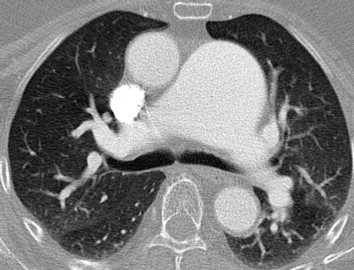Objective
Behçet’ s disease is a multiorgan disorder of unknown origin and can cause complications in cardiovascular system, central nervous system and respiratory system resulting from vasculitis of both arteries and veins. Vocal cord paralysis due to extralaryngeal cardiovascular pathologies, such as the thoracic aorta aneurysms and pulmonary artery aneurysm is defined as Ortner syndrome.
Case
A 78 year old female patient complaining about fever, fatigue, recurrent oral ulcers, and progressive hoarseness in the last 6 months admitted to our clinic. The medical history revealed that she had been followed with the diagnosis of Behcet’s disease for approximately 10 years and received corticosteroid treatment. Teleradiography revealed a prominent pulmonary artery. On transthoracic echocardiography, right and left ventricular size and function were normal, but an advanced degree expansion in the main pulmonary artery and its branches was observed. Doppler echocardiography revealed mild tricuspid and pulmonary regurgitation. Pulmonary artery systolic pressure measured through tricuspid regurgitant flow was 32 mmHg. In multislice CT angiography, main pulmonary artery was enlarged and measured to be 55 mm at the level of the aorticopulmonary window (Figure 1). Left pulmonary artery was 32 mm and right pulmonary artery was 42 mm. The patient underwent endoscopic examination of the larynx and the left vocal cord was found to be fixed in the paramedian position. Surgery was not considered due to existence of Behçet ‘s disease, advanced age of the patient and extent of the aneurysm involving both pulmonary artery and its branches. Clinical remission and radiographic resolution were achieved with cyclophosphamide and corticosteroid therapy and the patient was discharged with follow up recommendations.
The most common cause of Ortner’s syndrome is left atrial enlargement due to mitral stenosis. Mitral valve prolapse, thoracic aortic aneurysm, aortic dissection, cor pulmonale and pulmonary artery dilatation secondary to increased pulmonary artery pressure with any reason have also been described in etiology of Ortner’s syndrome. Ortner’s syndrome may arise from various intrathoracic pathologies of heart and great vessels but to the best of our knowledge this is the first report in the literature presenting a case of Ortner’s syndrome due to primary pulmonary artery aneurysm as a feature of Behçet’s disease. Consequently, it should be taken into consideration that hoarseness in a patient with Behcet’s disease may develop due to a pulmonary artery aneurysm and further evaluation should be performed.





